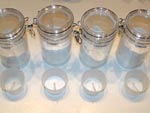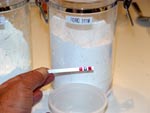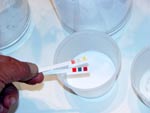|
Water or Zinc?
October 20, 2007 |
Zinc Silicate Crystalline Glaze Pottery
A chronicle of my recent
progress and a way for me to keep it straight in my head!
|
Please recall what I wrote
on 10-6-07 titled "Resolution
of Water Woes?". I thought I had the problem nailed, believing that my
calcium carbonate laden, basic (pH ~7.5) water was causing the problem.
Again the problem was that my glaze began shrinking significantly and
peeling off my pots on drying and falling off in chunks during firing. Now I
don't believe that is true and feel the real problem lies with the state of
calcination of the zinc oxide I am using. At least that is the theory of the
day.
At the recommendation of a
friend I made a 50g batch of my
8%
titania base substituting 2% bentonite for the kaolin and 1% Epsom salt
for the CMC. This was no better. It was a little "thinner" than normal, but
dewatered so fast on application to bisque that it was impossible to spread.
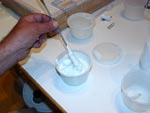 Then I
prepared a new batch of my original formulation using de-ionized water
expecting to see a repeat of the best test from 10-6-07, specifically a
glaze which is very fluid having "Loose - bubbles coming up" as it was
mixed. Much to my chagrin this was not the case. It was the stiffest thing
I've seen yet. I mean it had the consistency of "Fluff" or
mayonnaise. What a
bummer to say the least. And why was this different than before? I still
have no idea.
Then I
prepared a new batch of my original formulation using de-ionized water
expecting to see a repeat of the best test from 10-6-07, specifically a
glaze which is very fluid having "Loose - bubbles coming up" as it was
mixed. Much to my chagrin this was not the case. It was the stiffest thing
I've seen yet. I mean it had the consistency of "Fluff" or
mayonnaise. What a
bummer to say the least. And why was this different than before? I still
have no idea.
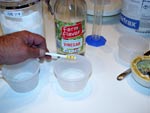 I
measured the pH of the glaze and found it was over 10! Damn! That's a lot
higher than what I would expect coming from my pH 7.5 water and anyway...I
used De-ionized water....pH 7 on this batch! I added vinegar to lower the
pH. It took a fair amount of this mild acid to bring the pH down. At this
point my water to solids ratio was ~ 1.2. This is a far cry from .6 to .7.
And it was still as thick as before.
I
measured the pH of the glaze and found it was over 10! Damn! That's a lot
higher than what I would expect coming from my pH 7.5 water and anyway...I
used De-ionized water....pH 7 on this batch! I added vinegar to lower the
pH. It took a fair amount of this mild acid to bring the pH down. At this
point my water to solids ratio was ~ 1.2. This is a far cry from .6 to .7.
And it was still as thick as before.
At this point, still
believing the problem was pH related, all I could think of was to look at
the pH of each individual ingredient. I slurried a small amount of each of
silica, titania, zinc oxide and frit 3110 in water. The pH of the first
three were very nearly neutral. The pH of the 3110 was high and off the
scale that I was using....10+. At this point I began to feel that
there is no way my pH 7.5 tap water could be causing the problem.
While looking at the pH I
noticed that the zinc oxide slurry took on a very pasty consistency.
So pasty it was difficult to see the colors on the test strips. It was
forming what looked like a gel. Then it hit me....is my zinc really
calcined? And if it was, has it been changing over time? I have been working
out of the same 50 lb. bag which Bailey markets as calcined zinc. It is
really calcined though. The bag says it is Zochem P106. Their website
www.zochem.com doesn't list this grade
but all the powders listed seem to be relatively high surface area to me,
ranging up to 7.99 (sq m / g?...they don't list units.)
Can calcined zinc become
un-calcined? What surface area does one
want in a calcined zinc suited for making crystalline glazes? What are the
other characteristics to look for? A certain packed density? Particle size?
I believe the main property should be one that makes a glaze that can be
dispersed in ~.6 to .7 g water / gram of solids, pass through an 80 mesh
sieve easily and stick to the pot surface when de-watered.
I fired a small alumina
crucible loaded with zinc oxide to see what happens during calcination. I
thought I recalled someone wrote the best temperature was 875C. This firing
got away from me and got up to ~950C before I shut it off. I was amazed that
the powder shrank to almost 1/2 it's original size. The best part was after
removing the chunky rocks from it I was able to make a slurry of like I did
for the pH test which did not gel!
I loaded 2 quartz trays with zinc oxide and fired them for 1/2 hour at 800C.
It shrank to 2/3 of it's original volume.
|
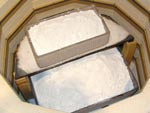 |
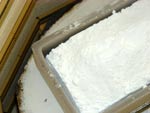 |
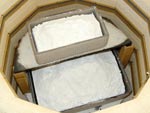 |
|
Before |
After 1/2 hr, @ 800C |
I was able to make a slurry
of it which did not gel too. I made glaze with it using my new Vita-Mix
blender (thanks Jamie. It's a nice machine.) with .7g water / g solids which
was very fluid and passed an 80 mesh sieve easily. This coated bisque well,
spread evenly and dried without cracking.
I wished I had a photo of
the glaze, but really want to reproduce it first.
Return to
Main Page
Phil Hamling
376
County Route 1
Warwick, NY, USA 10990

 Then I
prepared a new batch of my original formulation using de-ionized water
expecting to see a repeat of the best test from 10-6-07, specifically a
glaze which is very fluid having "Loose - bubbles coming up" as it was
mixed. Much to my chagrin this was not the case. It was the stiffest thing
I've seen yet. I mean it had the consistency of "Fluff" or
mayonnaise. What a
bummer to say the least. And why was this different than before? I still
have no idea.
Then I
prepared a new batch of my original formulation using de-ionized water
expecting to see a repeat of the best test from 10-6-07, specifically a
glaze which is very fluid having "Loose - bubbles coming up" as it was
mixed. Much to my chagrin this was not the case. It was the stiffest thing
I've seen yet. I mean it had the consistency of "Fluff" or
mayonnaise. What a
bummer to say the least. And why was this different than before? I still
have no idea.
